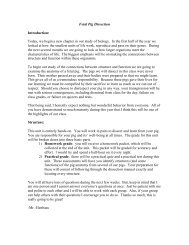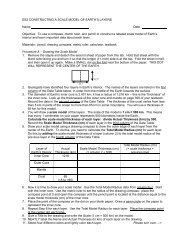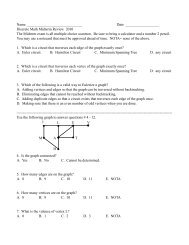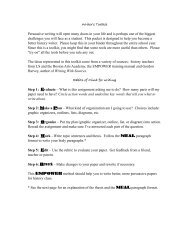L-S Technology Plan 2010-2013(pdf) - Lincoln-Sudbury Regional ...
L-S Technology Plan 2010-2013(pdf) - Lincoln-Sudbury Regional ...
L-S Technology Plan 2010-2013(pdf) - Lincoln-Sudbury Regional ...
You also want an ePaper? Increase the reach of your titles
YUMPU automatically turns print PDFs into web optimized ePapers that Google loves.
<strong>Lincoln</strong> <strong>Sudbury</strong> <strong>Regional</strong>High School<strong>Lincoln</strong> <strong>Sudbury</strong> SchoolDistrictGrades 9 - 12<strong>Technology</strong> <strong>Plan</strong><strong>2010</strong> - <strong>2013</strong>
L-S <strong>Technology</strong> <strong>Plan</strong> <strong>2010</strong> - <strong>2013</strong>TOPICS COVEREDA.IntroductionB.GoalsC.Leaders in Instructional <strong>Technology</strong>D.BudgetE.EvaluationF.<strong>Technology</strong> IntegrationG.<strong>Technology</strong> Professional DevelopmentH.Student Computer LiteracyI.Administrative UsesJ.Accessibility of <strong>Technology</strong>K.Infrastructure of ConnectivityL.Access to the Internet Outside of the school dayM.SummaryL-S TECHNOLOGY PLAN <strong>2010</strong>- <strong>2013</strong> page 1
L-S <strong>Technology</strong> <strong>Plan</strong> <strong>2010</strong> - <strong>2013</strong>A. Introduction<strong>Lincoln</strong>-<strong>Sudbury</strong> <strong>Regional</strong> High School is a one school district enrolling only students in grades ninethrough twelve. <strong>Lincoln</strong>-<strong>Sudbury</strong> <strong>Regional</strong> High School was built in 2004. The building projectallowed us to purchase a vast amount of computer equipment. Currently we have over 1000computers including laptops and 200 printers serving 1640 students and 240 staff members. Thereare 2 - 4 computers in each classroom, computers in the library, departmental computer labs andmobile labs for many departments. We have a great deal of hardware, but the personnel for themaintenance of the hardware and support for learning the potential of the new system is inadequate.The Educational <strong>Technology</strong> Coordinator serves as coordinator and Instructional <strong>Technology</strong>specialist. There is a network administrator and a computer technician servicing the schoolcommunity. In the fall of <strong>2010</strong>, due to federal grant monies a 0.25 FTE Instructional <strong>Technology</strong>specialist was added to the personnel. This will alleviate some of the backup of issues due toinadequate staffing over the past 6 years. An administrative database for students, staff andadministration is managed by a math teacher who is released 0.25 for this work. There has been littletime or money allocated for proper training. Although teachers now have computers, in everyclassroom they have not had time to plan for the effective use of these computers. The students mustfulfill a computer technology graduation requirement, in order to prepare students for the worldbeyond high school.B. GoalsOne of the goals is in-line with the school goal of increased communication within the building and tothe community at large. The current web site is managed by a club called the L-S Web Teamcomprised of students and two advisors. The teachers contribute to the web site by adding classpages, but are not required to do so. Another goal is to work with aging computers and infrastructurewithout funding to update hardware and appropriate personnel to meet the needs of the school. Forthis to occur it would the following is required:· Increase in school wide computer technology staffing· Professional development focused on the new technology using both face to face and on-linedelivery· Educating staff of the ethical uses of the Student Information Management system abiding byFederal, state and local student privacy laws· Training for faculty and administrators on a new administrative software package· Educate the L-S staff about security issues regarding the use of a computer network· To promote a better understanding of ethical computer use throughout the building for bothstudents and adultsThe obstacle to these goals is the insufficient funding on both the state and local level. <strong>Lincoln</strong>-<strong>Sudbury</strong> will have to prioritize what can be accomplished due to diminishing resources.C. LEADERS IN INSTRUCTIONAL TECHNOLOGYMany educators at <strong>Lincoln</strong>-<strong>Sudbury</strong> are interested in and excited about the possibilities computersoffer for classroom instruction. Over the past 2 years a wide variety of staff members have beenleaders in instructional technology. This representative group has worked to establish a model forstudents to become computer technology proficient. The committee is also interested in providingprofessional development for their colleagues. Many of the group participants supply computerL-S TECHNOLOGY PLAN <strong>2010</strong>- <strong>2013</strong> page 2
L-S <strong>Technology</strong> <strong>Plan</strong> <strong>2010</strong> - <strong>2013</strong>technology support for their department in a stipend position called a labervisor. There is still a needfor additional staffing in the computer technology department to keep up with hardware, softwareand instructional issues.Computer <strong>Technology</strong> Leaders◇ Leslie Belcher - Curriculum coordinator◇ Jim Berry - Computer teacher◇ Virginia Blake - Mathematics department coordinator◇ Amy Butler - Special Educator, Special Education labervisor◇ Donna Cakert - Regsitrar◇ Scott Carpenter - Superintendent-Principal◇ Nicole Digenis - Science department coordinator◇ Nancy Errico-Educational <strong>Technology</strong> Coordinator◇ David Grace - History teacher, history labervisor◇ Conor Hanover - History teacher, history labervisor◇ David Hosford - History teacher, history labervisor◇ Ken Kimura - Media arts teacher, FATA labervisor◇ Leslie Kmiec - Librarian◇ Leslie Knight - Science teacher, science labervisor◇ Dan Lewis - English teacher, English labervisor◇ Mike Malone - Math teacher, computer teacher◇ Paula Myers - Librarian◇ Meghan Notari- Math teacher, math labervisor◇ Carol Padden - FATA teacher, FATA labervisor◇ Dennis Phillips - Computer technician◇ Rebecca Reitz - Special Educator, Special Education Coordinator◇ Paul Sarapas - Fine and Applied Technical Arts Coordinator◇ Kim Schultz-Language teacher, language labervisor◇ Mark Sobkowicz-Science teacher, computer teacher, computer dept. liaison◇ Marci Stoda - Wellness teacher, Wellness labervisor◇ Dave Walsh - Network administrator◇ Seth Weiss - Math teacher, database administrator◇ Matt Wentworth - English teacher, English labervisorD. BUDGET<strong>Lincoln</strong>-<strong>Sudbury</strong> has been astute to provide a budget for the school wide computer technologyoperating budget. The budget has decreased close to 20% in the past 5 years. The new buildingproject 04-05 year resulted in a large capital investment in hardware. This equipment andinfrastructure is 5 years old. There are band-aid solution in terms of adding memory which of coursestill requires both time and money. Each year we plan to purchase two servers, but the replacementof computer labs and staff computers is problematic due to the volume of hardware. We havemanaged to keep the following line items in place for both the Academic Computer department andSchoolwide computers.◇ STUDENT HELP◇ SUPPLIES◇ SOFTWARE◇ CONFERENCE/TRAVELL-S TECHNOLOGY PLAN <strong>2010</strong>- <strong>2013</strong> page 3
L-S <strong>Technology</strong> <strong>Plan</strong> <strong>2010</strong> - <strong>2013</strong>◇ REFERENCE BOOKS◇ MAINTENANCE OF EQUIPMENT◇ TELECOMMUNICATION & NETWORK◇ NEW EQUIPMENT◇ REPLACEMENT EQUIPMENTIn regards to staffing, professional development and support, minimal funding has been available; thenumbers of computers along with the increasing school population can not be accommodated withthe limited present staffing. For example, in the old building there were 350 computers, 20 printersand 1600 students, faculty and staff. In the new building there is an inventory of 1625 pieces ofcomputer related equipment, and 1900 students and staff with the same support listed below.Staffing◇ 0.5 Educational technology coordinator◇ 0.75 Instructional technology coordinator◇ 1.0 Network administrator◇ 1.0 Computer technician◇ 0.25 administrative database◇ 8 stipend departmental labervisorsWhen appropriate we apply for local and global funding. We apply annually for the E-rate discounts.Outside funding opportunities require time to write which in turn takes from the time to help staffand students during the school day. Our funding issues now fall into all categories: hardware,software, staffing and professional development. The priority for funding needs to be applied tocomputer technology personnel, annual software updates and maintenance of the infrastructure. Theentire community has become dependent upon computers. When we lose power or we need toperform maintenance work on our network, students and staff feel crippled.E. EvaluationIndividual academic departments choose specific software for their subject matter. They work asdepartments to discuss what products are most successful with their students. The departmentsdiscuss computer technology on a regular basis. Although they do not have the budget for hardware,they indicate their needs to the Educational <strong>Technology</strong> Coordinator. The departments do have theauthority and operating budget to purchase subject specific software.Each fall a survey is administered to teachers for feedback regarding school wide computertechnology. Based on the feedback the Educational <strong>Technology</strong> Coordinator can decide whether thereis more user training necessary or whether we should abandon or revise a project. An emailconference to which all L-S staff members have access allows staff members to comment on currenttechnology in operation.L-S TECHNOLOGY PLAN <strong>2010</strong>- <strong>2013</strong> page 4
L-S <strong>Technology</strong> <strong>Plan</strong> <strong>2010</strong> - <strong>2013</strong>F. <strong>Technology</strong> IntegrationTeachers have been using computer technology at L-S since the early 1980s. Email is our mostconsistent and well used form of communication for all L-S staff members. At least 98% of teachersuse technology everyday, including some of the following areas: lesson planning, administrative tasks,communications, and collaboration. Teachers share information about technology uses with theircolleagues. Some staff members are exploring the use of Web 2.0 tools. However it is difficult for thecomputer technology personnel to support all requests with these services. Some teachers havedecided to use tools outside the school network which may or may not be problematic.According to a survey, 98% of teachers rely heavily upon the computer for their planning andeveryday work. Fewer teachers engage their students in proper uses of computer technology withinthe classroom. Based on an on-line survey administered in the fall of 2008, 68% of the teachers usecomputer technology with students each week, including: research, multimedia, simulations, datainterpretation, communications, and collaboration. This is an increase of 18% since 2005. Manyteachers feel students already have expertise with computers based on home access to computers.The school does have an Acceptable Use Policy posted on our website http://www.lsrhs.net/TechHelp/newpage/information/info.html The district is also CIPA compliant. It is unclear how many teachersare aware of the details of the AUP. It is printed in the student discipline code.Staffing regarding technology integration has not kept up with the district’s increasing demands. Thedistrict has a 0.5 FTE district-level technology director/coordinator. The district provides 0.5 FTEInstructional <strong>Technology</strong> Specialist for 170 faculty members. The benchmark for this position is 1FTE instructional technology teacher per 40-80 instructional staff. The district has one 0.25 FTEperson dedicated to data management and assessment.G. <strong>Technology</strong> Professional DevelopmentIn the school year 09-10 there were a few in-service workshops focused on computer technology.These included: training on our student information system, exploring Web 2.0 tools and the use ofInteractive whiteboards. During the summer of <strong>2010</strong> different department members are continuingtheir work with focus groups on the integration of technology in the curriculum and working on theirclass web pages.Computer technology has been at <strong>Lincoln</strong>-<strong>Sudbury</strong> since the early 80s. A few teachers in eachdepartment have advanced skills in technology integration and serve as role models to theircolleagues. Each department’s staff looks at new software in their discipline. Department memberswork together to learn and to teach with the software. The Educational <strong>Technology</strong> Coordinator andIntegration <strong>Technology</strong> Specialist (the same person) works directly with both the advancedtechnology teachers and beginning technology teachers to help them learn more about software whichwould enhance their teaching.Every year a survey is administered to the teachers regarding their technology proficiency and thetypes of workshops they would like available. The Massachusetts <strong>Technology</strong> Self-Assessment Toolhas been reviewed by our technology integration committee. The committee feels that this tool isquite thorough however, 95% of the teachers would find it too cumbersome and a burden to fill outgiven their overtaxed schedules. For this reason we choose to develop a more succinct on-line survey.L-S TECHNOLOGY PLAN <strong>2010</strong>- <strong>2013</strong> page 5
L-S <strong>Technology</strong> <strong>Plan</strong> <strong>2010</strong> - <strong>2013</strong>H. Student Computer LiteracyAt L-S we have a student expectation, “all L-S students are able to use technology appropriately tohelp create, investigate, and communicate”. The graduating class of 2009 was the first class expectedto complete computer technology graduation requirement. I feel confident that this new requirementwill assist in fulfilling our student expectation. An exit survey was administered in the spring of <strong>2010</strong>for all students enrolled in one of the required coursesThe goal of all courses which meet the requirement should strive to help students use computertechnology appropriately to help create, investigate, and communicate. Teachers in all disciplines willstill be encouraged to incorporate technology into their curriculum where appropriate. Hopefullywith this two prong approach we can better meet the needs of the students. This is in alignment withState standards and nation standards. This is not intended as a check list. We want student tobecome independent and life-long learners. Computer technology changes so rapidly students needto acquire the ability to learn with these changes.L-S Computer <strong>Technology</strong> Graduation RequirementEach student has the ability to use technology appropriately to help create, investigate, andcommunicate. Each L-S student will be required to take a 2 credit course in one of the designatedareas. Students will:* Acquire the ability to transfer computer skills learned in the course to other learning environments* Become comfortable experimenting with new computer software* Emphasize the ability for students to become more independent learnersIn a survey with 261 students who took a course which fulfilled the requirement., 80% of the studentsfelt comfortable experimenting with new software. 70% reported they could transfer the computersskills from the course to other situations and 68% felt they could tackle a situation with new softwareindependently.Teachers in all disciplines will still be encouraged to incorporate technology into their curriculumwhere appropriate. Hopefully with this two prong approach we can better meet the needs of L-Sstudents in a technology driven society.Visit the Massachusetts Department of Education Website to read the entire documentMassachusetts <strong>Technology</strong> Standards - Grades 9 through 12 – <strong>Technology</strong> Standards andExpectations http://www.doe.mass.edu/edtech/standards.htmlThroughout high school, as students take courses to prepare themselves for college and the workingworld, they should acquire increasingly sophisticated technology skills. Depending on the pathwaysand courses they choose to take, high school students will become more adept with certaintechnology tools than others. Moreover, as the curriculum demands more complicated learning tasks,students will discover advanced capabilities in tools such as database and spreadsheet applications.During high school, students also should have the opportunity to use more specialized technologytools that enhance their learning. These might include simulation software, geographic informationsystems, computer-aided design software, or any of a wide variety of content-specific tools. Inaddition, students should have the opportunity to learn how to write code in a commonly usedprogramming language.L-S TECHNOLOGY PLAN <strong>2010</strong>- <strong>2013</strong> page 6
L-S <strong>Technology</strong> <strong>Plan</strong> <strong>2010</strong> - <strong>2013</strong>By the completion of high school, students should have developed an appreciation for the capabilitiesof technology resources, as well as an understanding of how these tools can be used for lifelonglearning. In addition, students should be knowledgeable about the role technology plays in variousfields of work, enabling them to better plan for their careers in the 21st century. (From the Mass DOE)Answers to Frequently Asked QuestionsEach year a list of courses which meet the computer technology requirement will be reviewed. Here isan example of courses that would meet the requirement: Creative Computing, Web Publishing, Flash,Digital Imaging, Game Programming, Robotics, CAD, Architectural Design, Introduction toProgramming, Intermediate Programming, Advanced Programming, Topics in Algebra II, Topics inAdvanced MathWhat if a student already knows everything offered in the above courses? In the field ofcomputer technology the change is rapid. It is highly unlikely any student or teacher is well versed inall of the above courses. Due to the nature of the ever changing field of technology the moreexposure to the use of different software the more prepared the student will become.Revised July 2007I. Accessibility of <strong>Technology</strong>In the new building students have more computers to access. The old building offered approximately5 students to 1 computer while in the new building it is closer to 3 students to 1 computer. This was amajor change in terms of access. Previously to save files an account was created on need basis: now,in accordance with our Acceptable Use Policy, we have developed a system where each L-S member(student or staff) must have a network user name and password to use any features of the computer.The new system is a learning process for both students and staff members. Faculty members haveaccess to the initial student name and password and are encouraged to teach the students how to usethe system when the students enter a computer lab. Problems arise when a student who wants to usethe school computers has had no teacher introduce the class to the computer lab.In addition classroom computers, there are 6 computer labs with 26-30 computers associated witheach department and one classroom with 26 computers shared by 3 departments. The library has 22computers for student use in the main room. There is an instructional library classroom whichhouses a smart board and 4 desktop computers. There are 11 mobile computer labs with 15computers each available for teacher sign up for their classes. These computers are not available forindividual student sign up. Ample desktop computers and portable computers for students to usewithin the building.The school acquired approximately 800 new computers in this building project. This was wonderful!However, now we have 800 five year old computers. Fortunately we do have a line item in the schoolwide computer budget which allows for replacement of equipment. This may mean that other lineitems such as supplies or maintenance of equipment will need to decrease. There is an annual budgetprocess which the Educational <strong>Technology</strong> Coordinator participates in each fall for the next fiscalyear.L-S TECHNOLOGY PLAN <strong>2010</strong>- <strong>2013</strong> page 7
L-S <strong>Technology</strong> <strong>Plan</strong> <strong>2010</strong> - <strong>2013</strong>Along with proper planning and attention concerning hardware, the personnel needed to maintainthis hardware can not be forgotten. It is of no value to have non-operating computers in a classroomenvironment. Administrators and support staff rely heavily upon the computers and servers,malfunctions impact their productivity. The running of a school network has become an intricateinfrastructure which requires ongoing maintenance. In the old building there was a networkadministrator and a computer technician. They serviced 200 computers per person. In the newbuilding the ratio is 600 computers per technician. This is astounding! Clearly more personnelresources are essential to the technology infrastructure. There are two possible directions to pursue iffunding were available. Another computer technician could be hired or certain faculty memberswithin each department could be released from teaching classes. We had a model at one time where ateacher was released in each department to help department members with both software andhardware issues. This model was effective for faculty members, but was discontinued due to lack offunding.J. Administrative UsesComputers have been an integral part of the administrative work at L-S. Since we are a one schooldistrict, our financial personnel is housed within the building. This department utilizes PC computersand has their own server. The computers will be replaced with Apple computers and will run aWindows environment. This will be helpful when it comes time to replace the Apple computers theycan be placed in other parts of the building. The school computer support personnel assists thebusiness office in terms of the school wide network and any emergency problems with theircomputers.Other areas of administrative use include the registrar, student services, scheduling, curriculumcoordinator, housemasters, counselors, nurses and special education. Over the past five years thestate and federal governments have been demanding in terms of both staff and student reporting viathe web. The state requires more than 52 data elements for each student be maintained on ournetwork and transmitted during different times in the year. The registrar has taken on this task whichis a large increase to her workload. There is a new Educational Data Warehouse which someone hasto learn how to use. The data needed for Education Personnel Information Management System,(EPIMS) has put an increased work load on our Personnel Director, Scheduling and Curriculumcoordinators. Student MCAS results dictate success plans which now have to be developed andworked into our Student Information Systems. In terms of scheduling and report cards, which wereonce customized in house by math teacher Seth Weiss, a new administrative package was purchasedin 2002 by an outside vendor (Information Marketing Group) called iPASS. This web based softwareenables administrators, teachers and students to access different information. However, theimplementation has been slow and has required a great deal of customization on the part of ourdatabase manager. We are also working closely with the vendor in terms of customizing the productto the way that L-S does things rather than changing our procedures to meet the software’sconstraints. The external forces require schools to do more while providing less funding. This hastaken a great toll on our staff. This increased work takes time, energy and communication.The Special Education department uses a web based piece of software to generate IndividualizedEducation Programs. Training of the special education staff takes place within the special educationstaff with support from the computer technology staff. The counseling department has started to usea web based program to assist in college information for juniors and seniors.L-S TECHNOLOGY PLAN <strong>2010</strong>- <strong>2013</strong> page 8
L-S <strong>Technology</strong> <strong>Plan</strong> <strong>2010</strong> - <strong>2013</strong>Each of these areas demand that the computer staff remain in close contact with staff members andtheir computer skills and requires that the computer staff learn the new software packages in order tosupport the faculty learning the new applications.K. Infrastructure for ConnectivityThe <strong>Lincoln</strong>-<strong>Sudbury</strong> <strong>Regional</strong> HS computer network consists of redundant gigabit fiber connectionsfrom the main server closet to each of 20 wiring closets and 10/100 Mbps copper (Category 5e) wiringto each network jack. Each classroom has between seven and fourteen network jacks which provideindependent 10/100 Mbps connections to the wiring closets. We also have over 90% coverage for our802.11b/g/n wireless networking and have planned additional coverage to provide 100% coverageinside the building with some connectivity in the courtyards outside the building. This wirelessnetwork is available around the clock and students are allowed to bring in their own portablecomputers which will be filtered through the L-S network. Our Internet feed for the public file, weband email servers is a 15 Mbps microwave link. For general Internet access we also have a 6 Mbpscable modem and a 20 Mbps fiber optic connection that supplement the 15 Mbps microwave link, andall three are connected through a CIPA compliant filter for the wireless and hard-wired network users.Our main server room consists of a rack of servers providing separate email, web, DNS, database,backup and file servers all connected to the gigabit fiber network with 32 independent gigabit copperconnections. We have seven separate servers for file sharing: one for each grade of students, one forfaculty and staff, one for administrators, and one for the yearbook staff and students. All servers areeither using RAID 1 or RAID 5 volumes for hardware redundancy and are backed up to a 1.6 terabytetape library nightly.Since the teachers have access to a high speed network and many computers available they makeregular visits with their classes to the departmental computer labs. Two departments at L-S use thecomputers exclusively for their curriculum. The computer department teaches: Creative Computing,Web Publishing, Robotics, Introduction to Programming, Game Programming and IntermediateProgramming. The FATA (Fine Applied and Technical Arts) program teaches courses in DigitalImaging, Digital Photography, Film, Media literacy, Architectural Design and Engineering Designprocess. The librarians run a ninth grade orientation on the uses of information technology withthe aid of a SMART Board and teach a unit in Creative Computing. Students are required to takea 2 credit course which helps encourages them to learn more about the uses of computer technologyin our society.L. Access to the Internet outside the School Day<strong>Lincoln</strong>-<strong>Sudbury</strong> works with students to maintain the school web site. This gives the students theopportunity to acquire skills in web publishing and design. There are definite pros and cons to thissystem. The positive side is the student involvement in their school web site. The negative side is thatoften times information is not posted or removed in a timely fashion. In order to assist in the upkeepof the website all faculty members and interested staff members are allowed access to certain portionsof the web site. Ideally time and resources should be dedicated to an adult member of the staff.Currently two staff members are paid a stipend to supervise the students on the Web Team and assiststaff members working on their web pages.L-S TECHNOLOGY PLAN <strong>2010</strong>- <strong>2013</strong> page 9
L-S <strong>Technology</strong> <strong>Plan</strong> <strong>2010</strong> - <strong>2013</strong>Students have access to computers both before and after school hours but must be with a teacher or inthe library where there is adult supervision. It is does not make sense to leave expensive equipmentunattended.M. Summary<strong>Lincoln</strong>-<strong>Sudbury</strong> is extremely fortunate to have a powerful network infrastructure and large amountsof hardware. The faculty, staff, administrators and students are eager to use the available computertechnology. Hopefully more funding will become available within the next few years to supportadditional personnel to provide professional development along with software/hardware support.L-S TECHNOLOGY PLAN <strong>2010</strong>- <strong>2013</strong> page 10


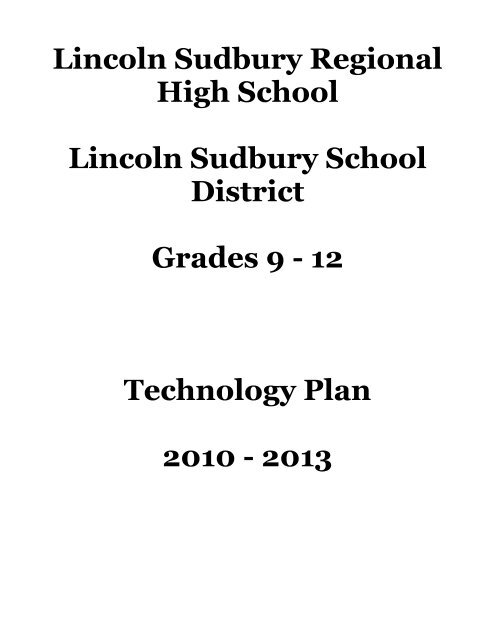



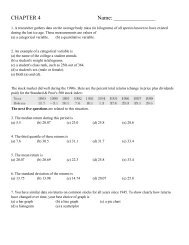
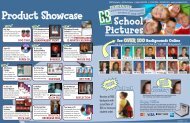
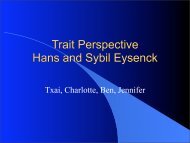
![';1asAu ro; las I sgeo8 leuo!]eslanuol aql utelqo o1 palenttouJ ue I ...](https://img.yumpu.com/49072782/1/190x221/1asau-ro-las-i-sgeo8-leuoeslanuol-aql-utelqo-o1-palenttouj-ue-i-.jpg?quality=85)
